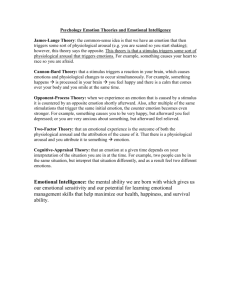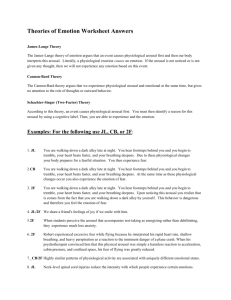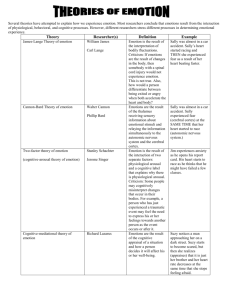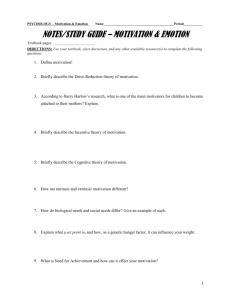Learning Targets: Motivation and Emotion (6–8%)
advertisement
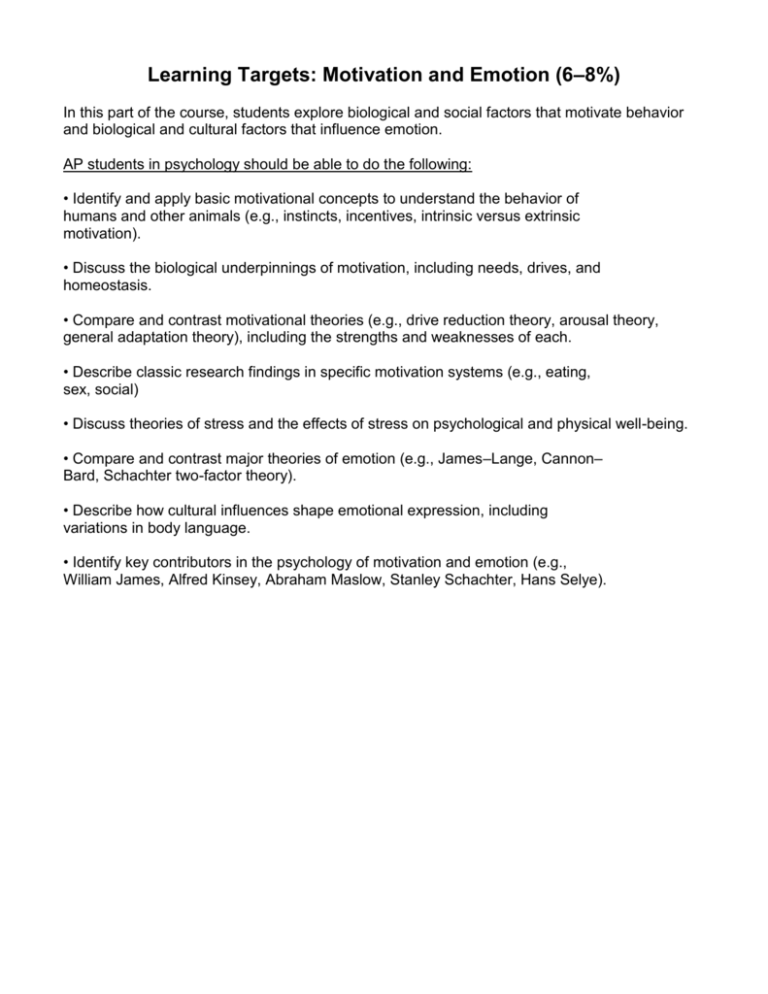
Learning Targets: Motivation and Emotion (6–8%) In this part of the course, students explore biological and social factors that motivate behavior and biological and cultural factors that influence emotion. AP students in psychology should be able to do the following: • Identify and apply basic motivational concepts to understand the behavior of humans and other animals (e.g., instincts, incentives, intrinsic versus extrinsic motivation). • Discuss the biological underpinnings of motivation, including needs, drives, and homeostasis. • Compare and contrast motivational theories (e.g., drive reduction theory, arousal theory, general adaptation theory), including the strengths and weaknesses of each. • Describe classic research findings in specific motivation systems (e.g., eating, sex, social) • Discuss theories of stress and the effects of stress on psychological and physical well-being. • Compare and contrast major theories of emotion (e.g., James–Lange, Cannon– Bard, Schachter two-factor theory). • Describe how cultural influences shape emotional expression, including variations in body language. • Identify key contributors in the psychology of motivation and emotion (e.g., William James, Alfred Kinsey, Abraham Maslow, Stanley Schachter, Hans Selye). Lesson One: Theories of Motivation What is the difference between: Motivation – Motive(s) – How are motivation and instinct different? Biological Motives Social Motives Define Drive Reduction Theory: Example of Drive Reduction Theory: Drive: Homeostasis: What are some possible implications of Drive Reduction Theory? 1. 2. Incentive: Define The Push-Pull Theory of Motivation Example of Push-Pull Theory – Arousal: Yerkes-Dodson Law – Examples - Why is Maslow’s Theory debated in regards to the topic of motivation and emotion? Lesson Two: Hunger, Thirst, and Eating Disorders How does your level of glucose affect your brain and body? What research has been done on rats in regards to hunger and brain surgery? What are a few environmental factors that affect our hunger? 1. 2. 3. What do learning and survival have to do with hunger? What happens when we: Gain Weight – Lose Weight – Set Point: Basal Metabolic Rate: Do you find that your weight fluctuates or do you have a regular “set point?” How can knowing your basal metabolic be an excellent tool for weight control/loss? Anorexia Nervosa: Bulimia: Lesson Three: Sex and Motivation Briefly describe the “Journey of Sexual Arousal.” When you think of societal norms when talking about sex, what comes to mind? How do psychologists explain sexual orientation? What is the difference between males and females in regards to choosing a partner for reproduction? Males – Females – Briefly describe Master’s and Johnson’s research on sexual response cycle. Research Sexual Response Cycle Stages: 1. 2. 3. 4. Lesson Four: Social Motivation What is Achievement Motive? What do “high achievers” want to do? Do you consider yourself a “high achiever?” How is a Thematic Apperception Test (TAT) used to measure motivation? According to David McClelland, what is the difference between: High Achievers – Low Achievers - Define and describe Atkinson’s Theory of Motivation: What are your thoughts about his theory? Intrinsic: Extrinsic: How is the Over Justification Effect related to Intrinsic and Extrinsic rewards? Define Affiliation Motive and give an example where you have you seen it in your life: Social Conflict Situations: Social Conflict Situation: Description: Approach-Approach Avoidance-Avoidance Approach-Avoidance Multiple Approach Briefly describe Selye’s General Adaptation Syndrome (GAS): 1. “Real Life” Example: 2. 3. Lesson Five: The Emotional Experience What are the three main components of the “Emotional Experience?” 1. 2. 3. In what ways do each of these parts of the brain handle emotion? Autonomic Nervous System – Neurotransmitters – Endocrine System – Amygdala – Frontal Lobes – Right Hemisphere – Left Hemisphere – Briefly describe Paul Ekman’s research on emotion: What are the Two Dimensions of Emotion? 1. 2. 5 Main Theories of Emotion: James-Lange Theory The James-Lange theory of emotion argues that an event causes physiological arousal first and then we interpret this arousal. Only after our interpretation of the arousal can we experience emotion. If the arousal is not noticed or is not given any thought, then we will not experience any emotion based on this event. EXAMPLE: You are walking down a dark alley late at night. You hear footsteps behind you and you begin to tremble, your heart beats faster, and your breathing deepens. You notice these physiological changes and interpret them as your body's preparation for a fearful situation. You then experience fear. Cannon-Bard Theory The Cannon-Bard theory argues that we experience physiological arousal and emotional at the same time, but gives no attention to the role of thoughts or outward behavior. EXAMPLE: You are walking down a dark alley late at night. You hear footsteps behind you and you begin to tremble, your heart beats faster, and your breathing deepens. At the same time as these physiological changes occur you also experience the emotion of fear. Schachter-Singer Theory According to this theory, an event causes physiological arousal first. You must then identify a reason for this arousal and then you are able to experience and label the emotion. EXAMPLE: You are walking down a dark alley late at night. You hear footsteps behind you and you begin to tremble, your heart beats faster, and your breathing deepens. Upon noticing this arousal you realize that is comes from the fact that you are walking down a dark alley by yourself. This behavior is dangerous and therefore you feel the emotion of fear. Lazarus Theory Lazarus Theory states that a thought must come before any emotion or physiological arousal. In other words, you must first think about your situation before you can experience an emotion. EXAMPLE: You are walking down a dark alley late at night. You hear footsteps behind you and you think it may be a mugger so you begin to tremble, your heart beats faster, and your breathing deepens and at the same time experience fear. Opponent Process Theory: Description We have pairs of emotions that act in opposing pairs, such as happiness and sadness, fear and relief, pleasure and pain. When one of these is experienced, the other is temporarily suppressed. This opposite emotion, however, is likely to re-emerge strongly and may curtail or interact with the initial emotion. Thus activating one emotion also activates its opposite and they interact as a linked pair. To some extent, this can be used to explain drug use and other addictive behavior, as the pleasure of the high is used to suppress the pain of withdrawal. Sometimes these two conflicting emotions may be felt at the same time as the second emotion intrudes before the first emotion wanes. The result is a confusing combined experience of two emotions being felt at the same time that normally are mutually exclusive. Thus we can feel happy-sad, scared-relieved, love-hate, etc. This can be unpleasant but as an experiential thrill it can also have a strangely enjoyable element (and seems to be a basis of excitement). Example A person buys something to cheer themselves up but later feels guilty at having spent so much. So they buy something else to cheer up again. A thrill seeker goes rafting. The excitement of the journey is a mix of fear of the next rapids and relief at having survived the last one. Theory James Lange Cannon Bard Schachter – Singer Lazarus Opponent Process Main Idea Real Life Application Critique

